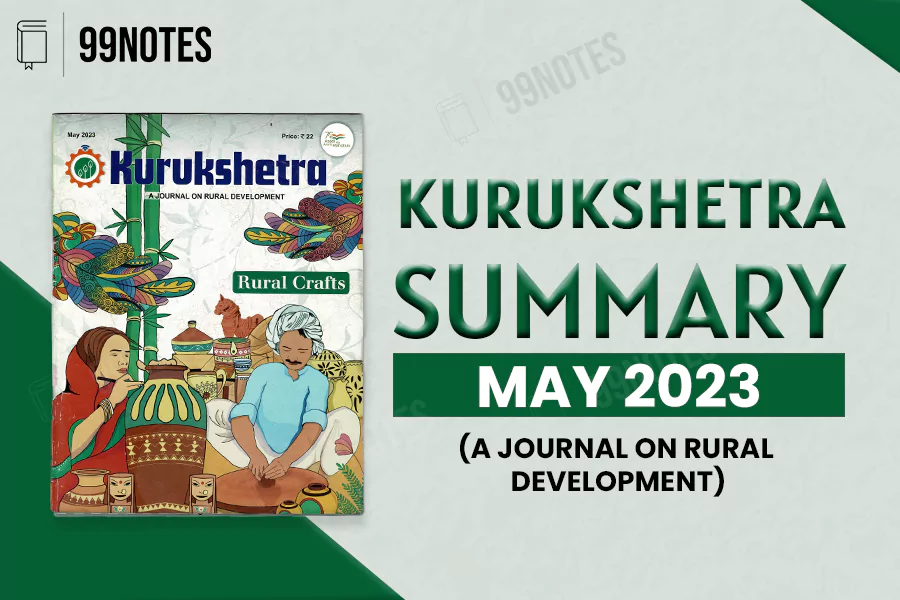Kurukshetra Summary, May 2023
Chapter 1: Potential of the Rural Crafts
- Chapter 1: Potential of the Rural Crafts
- Introduction
- The Potential of Rural Crafts
- Steps by the Government of India to promote rural crafts:
- Global Recognition
- Titbits for Prelims
- Conclusion
- Chapter 2: Rural Crafts through Ritualistic and Indigenous Traditions
- Introduction
- Tracing the legacy
- Puppetry
- Shadow Puppetry
- Toys
- Rituals and Traditions in Art and Craft
- Titbits for Prelims
- Conclusion
- Chapter 3: Betting Big on Bamboo
- Introduction
- Green Gold: India’s Bamboo Wealth
- Conclusion
- Chapter 4: J&K: Changing Dynamics of Handicrafts Sector
- Introduction
- History
- Handicrafts in the Present Day
- Srinagar as UNESCO Creativity City
- E-commerce platforms
- Startup in the handicraft Industry
- conclusion
- Chapter 5: Rural Crafts for Livelihood
- Chapter 6:Fostering Rural crafts through one District one product
- Chapter 8:Promotion and Development of Handloom and Handicraft Sector
Introduction
India has an affluent tradition of rural crafts passed down from many generations. These traditions can become a source of livelihood for many rural communities if they are provided with proper skills, entrepreneurship knowledge and government support.
The Potential of Rural Crafts
1. It can contribute immensely to the Rural Economy and increase the rural communities’ living standards, leading to the overall development of countries.
2. It encourages rural tourism as rural crafts attract tourists to India.
3. It can reduce rural-urban migration and potentially solve the issue of India’s unplanned urbanisation.
4. It preserves India’s rich culture and heritage.
5. The local cultural goods created using centuries-old esoteric knowledge, Skill sets, and local labour supply organically embody the “Made in India” ideology and the “Aatma Nirbhar Bharat” values.
Steps by the Government of India to promote rural crafts:
1. One District One Product (ODOP) is one such rural development programme introduced by the government of India to exalt traditional Industries and handicrafts in every district of the country.
2. The government has identified 8 craft villages nationwide under the ‘Linking Textile with Tourism’ initiative to promote crafts and tourism at a single location.
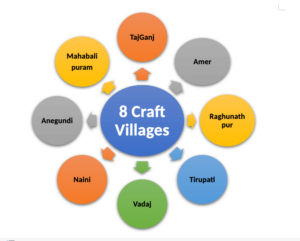
- Saras Aajeevika Mela: An annual event promoting rural livelihoods and products organised by the Ministry of Rural Development.
- Surajkund Crafts Mela: It provides a stage for artisans from all over India to display their skills and creations.
- Aadi Mahotsav: It is a yearly project of the Ministry of Tribal Affairs’ Tribal cooperative marketing development federation limited (TRIFED) to celebrate the spirit of tribal culture.
- Ek Bharat Shreshtha Bharat: This programme aims to ease interaction and promote mutual understanding between people of different states/UTs through the concept of state/UT pairing.
- The government also promulgates handicraft export through international trade fairs and exhibitions, export promotion council, and provides financial assistance to artisans and craftsmen.
Global Recognition
- The united nations world tourism organisation has chosen Telengana’s Pochampally village as one of the top tourist destinations (UNWTO).
- The G20 summit can further provide Indian handicrafts better access to the international market.
Titbits for Prelims1. Mahatma Gandhi gave the philosophy of gram swaraj. 2. Ekta Mall at the “Statue of Unity “in kevadia, Gujrat, is an important centre for rural craft promotion. 3. Pochampally is famous for the handloom industry, especially Pochampally Sarees, also renowned as Ikat.
|
Conclusion
A collective effort from all stakeholders to nurture and promote responsible tourism practices that benefit the local communities is the need of the hour.
Chapter 2: Rural Crafts through Ritualistic and Indigenous Traditions
Introduction
Rural crafts in India often have a potent cultural and religious importance and are rooted in the traditions of the communities that created them.
Tracing the legacy

Puppetry
1. Puppetry has always been integral to India’s rich cultural heritage and traditions.
2. Some of the earliest references to puppetry in India can be found in ancient texts such as Natyashastra and Mahabharata, which describe the use of puppets in theatrical performances.
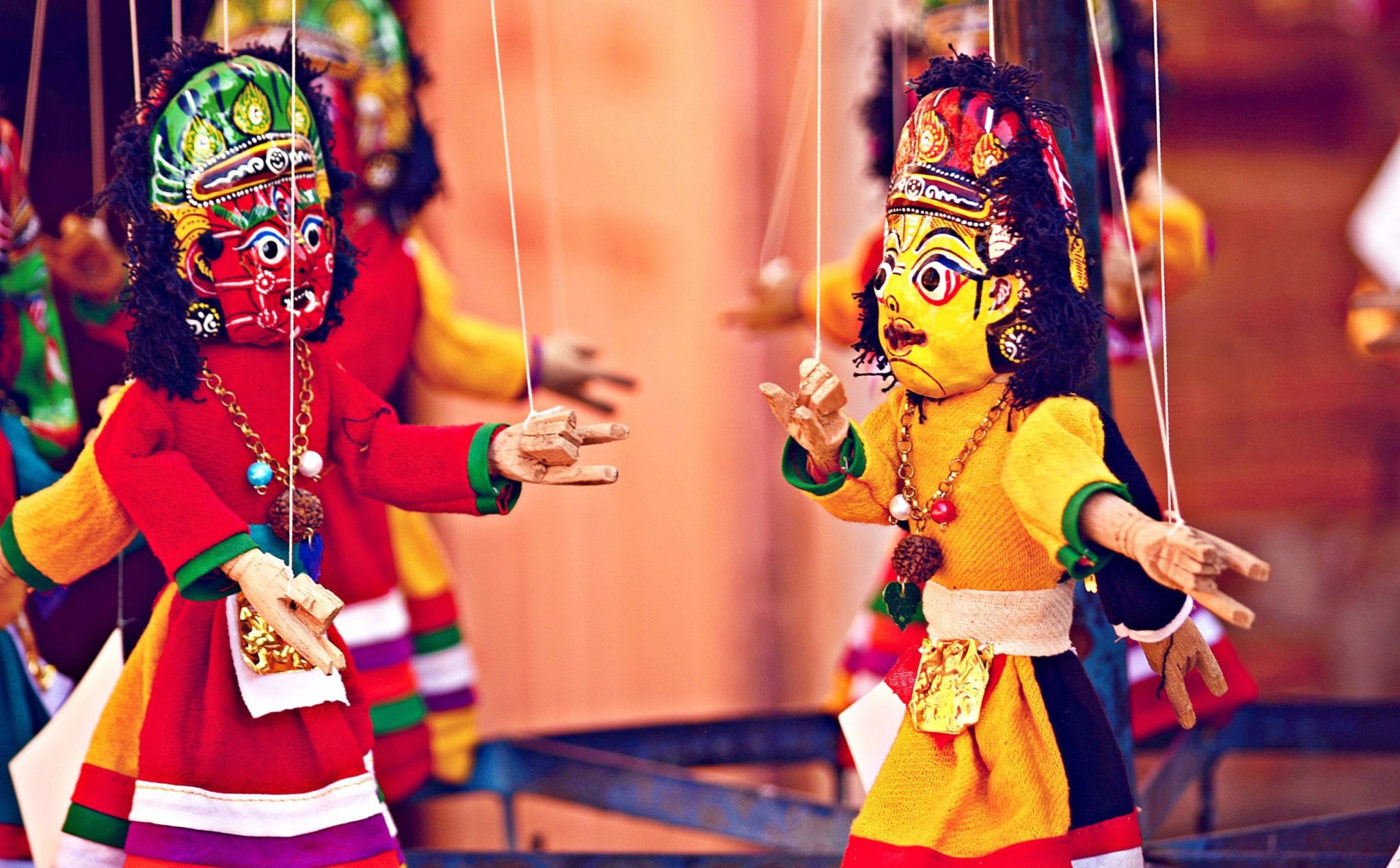
https://www.auchitya.com/indian-puppetry-a-rich-ancient-art-that-is-slowly-fading/
Shadow Puppetry
1. Tholu Bommalata and Tholpavakoothu are traditional forms of shadow puppetry that originated in South India.
- They use leather puppets that are intricately carved and painted.
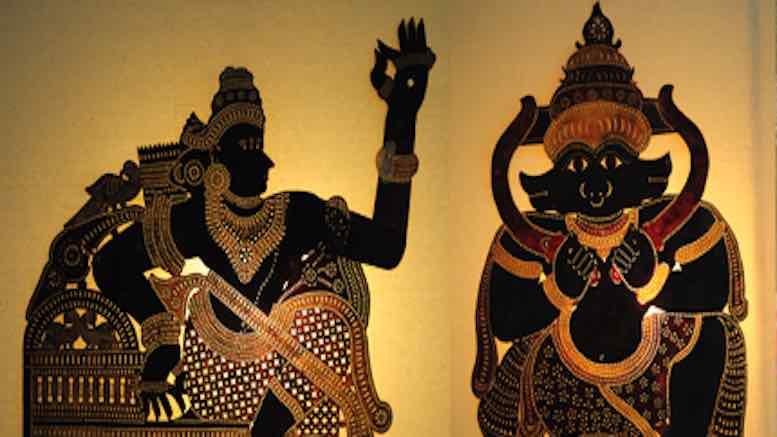
https://hindupost.in/society-culture/tholpavakoothu-the-vanishing-art-of-shadow-leather-puppetry/
Toys
1. Kondapalli toys originated during the Vijayanagara Empire.
- According to local folklore, the Aryakshatriya community was known for their wood carving skills, first created Kondapalli toys.
- During the Sankranti festival, Kondapalli dolls create a display known as Bommala Kovulu.
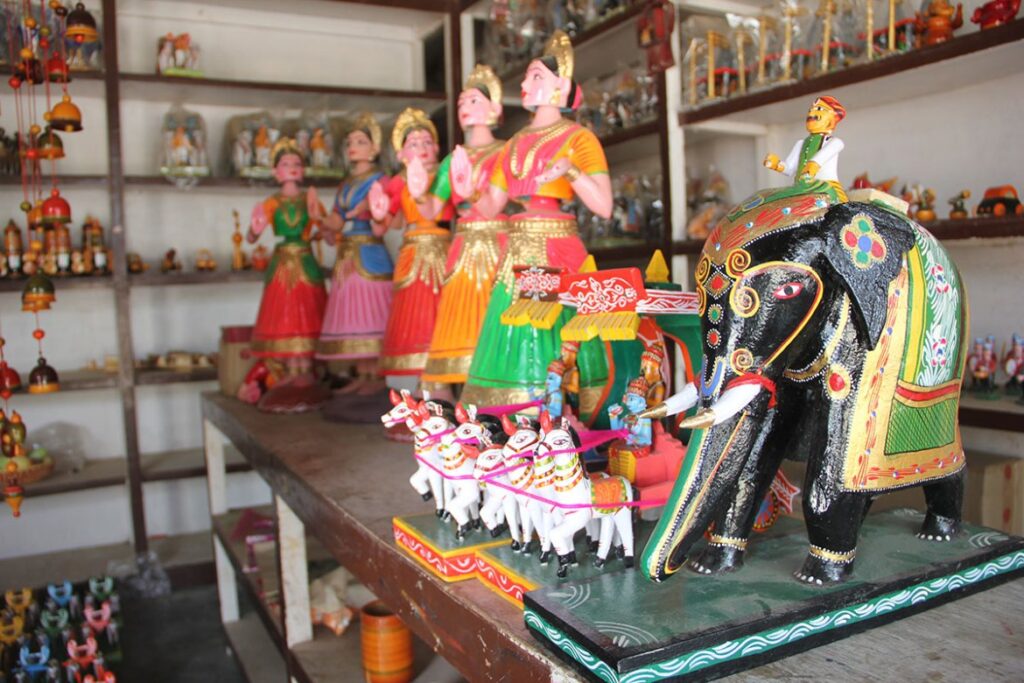
Rituals and Traditions in Art and Craft
Before beginning any craftwork, many communities observe certain preparatory rituals. Some of them are:
|
Kutchi artisans in Gujarat follow the “Gadhvi” tradition by lighting a lamp, singing folk songs and praying for protection and blessings in their workshop. |
|
The Madhubani painters in Bihar only paint during the waxing phase of the moon. |
|
Making the Chauri in Sikhism is an important craft, which is used to fan the Guru Granth Sahib. Moreover, in Sikkism, it is a sign of respect and devotion. |
Titbits for Prelims1. Jhabua doll plays a significant role in the livelihood of the rural people of Madhya Pradesh. 2. Kathputli is a string puppet theatre native to Rajasthan. 2. khujra pottery originated in Uttar Pradesh. 3. Lambani embroidery is practised in the state of Karnataka. 4. Warli painting is one of the most significant paintings of Maharashtra. 5. Ganjifa is a traditional card game that originated in Persia and was brought to India by the Mughals. |
Conclusion
lack of recognition, dwindling demand are some of the most prominent challenges that many rural crafts in India face nowadays. However, through various government efforts, participatory movements like SPIC MACAY and collaborations with designers and entrepreneurs can solve the issue in a very effective manner.
Chapter 3: Betting Big on Bamboo
Introduction
Bamboo is known as green gold due to its unlimited potential for creating eco-friendly products.
Green Gold: India’s Bamboo Wealth

National Bamboo Mission: Helping Realise the Commercial Potential
The Department of Agriculture and Farmers Welfare has been implementing the re-structured National Bamboo Mission (NBM) since 2018-19 to develop a complete value chain of the bamboo sector to link growers with consumers. The NBM is implemented through State Bamboo Missions and Bamboo Technology Support Groups.

https://twitter.com/AgriGoI/status/1217763021071831041
|
Bamboo charcoal 1. Bamboo charcoal is obtained from the culms of mature bamboo trees burning at temperatures from 600 to 1200 °C. 2. It has very limited use within the domestic market, but it has huge export potential in an international market, growing at 6% per annum. 3. It is also used in soil nutrition 4. It is also used as raw material for Activated Charcoal.
|
|
Titbits for Prelims 1. North East Cane and Bamboo Development Council (NECBDC)-Guwahati. 2. Indian Council of Forest Research and Education(ICFRE)-Dehradun. 3.Kerala Forest Research Institute(KFRI)-Peechi,Kerala. |
Conclusion
Connecting to the urban population and global stakeholders is a major challenge for rural people. E-trading platforms like enam,gem.gov.in portals can be a suitable way forward.
Chapter 4: J&K: Changing Dynamics of Handicrafts Sector
Introduction
The handicrafts sector has long been an unabated segment of the culture and economy of J&K.A wide variety of items such as shawls, carpets, crewelwork, papier Mache, Copper Work and wooden items are crafted by skilled artisans in the region, providing employment opportunities to many people.
History
Shahi Hamdan, a 14th-century Persian Sufi Saint, is credited for developing handicrafts in J&K.
Handicrafts in the Present Day
- The process of globalisation impacted the handloom industry immensely. However, the government is also taking several initiatives to revitalise the sector and promote the region’s rich cultural heritage.
- The government of J&K introduced a holistic policy for the Handicrafts and Handloom sector,” wool processing, handloom and handicrafts policy-2020″.
- Aim of wool processing, handloom and Handicrafts policy-2020
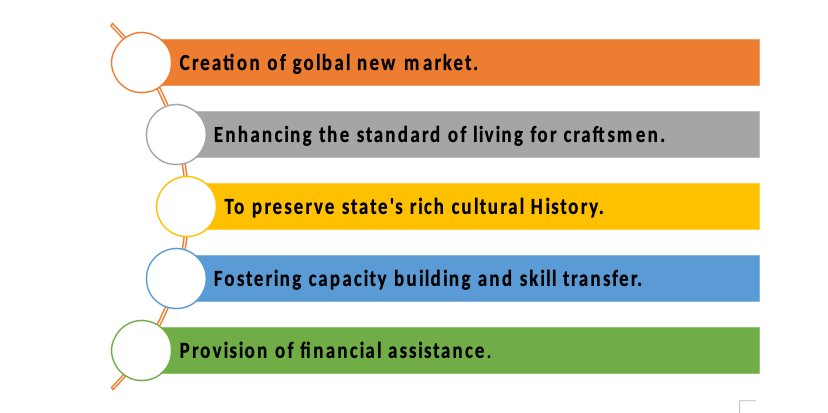
-
G.I.Tag
1. First introduced in 2007.
2. The sole purpose was to prevent cheap machine-made fakes from damaging the genuine Kashmir handicraft brand.
3. Few recently added G.I.registered Kashmiri products:
-
Kashmir Sonzi.
-
Kani Shawl.
-
Kashmir walnut wood carving.
-
Kashmir paper machine and khatam band.
-
Srinagar as UNESCO Creativity City
- Recently Srinagar has been included in UNESCO’s Creativity City network, which gave it an opportunity to promote its potential worldwide.
- The Department of Handicrafts also initiated a “crafts safari” to boost the local craftwork ecosystem.
E-commerce platforms
The rise of e-commerce platforms, like Etsy, Amazon Handmade etc., has impacted the handicraft industry significantly.
Startup in the handicraft Industry
- Kashmir Box and Kashmir Origin are examples of the two most prominent startups in the handicraft Industry within J&K.
- These startups work directly with artisans from the region, bringing their products to customers worldwide.
conclusion
Handicrafts have been a significant contributor to the economy of Jammu and Kashmir for centuries. Moreover, the industry has the potential to continue to play an essential role in the global economy, provided that appropriate measures are taken to support and promote it.
Chapter 5: Rural Crafts for Livelihood
Introduction
1. The earliest evidence of handloom weaving was observed from the Indus Valley civilisation, Rigveda, Ramayana, etc. Greek historian Herodotus, Kautilya has also mentioned the same.
2. A paper by the Exim Bank of India (2019) stated that art and crafts constitute India’s creative economy.
3. Crafts means an occupation, trade or activity requiring manual dexterity or artistic skill.
4. In Indian terminology, handicrafts are referred to as ‘hastshilp’, ‘dastkari’, ‘karigari’, ‘hastakala’ etc.
Importance of craft
According to official estimates, India is home to 7 million artisans.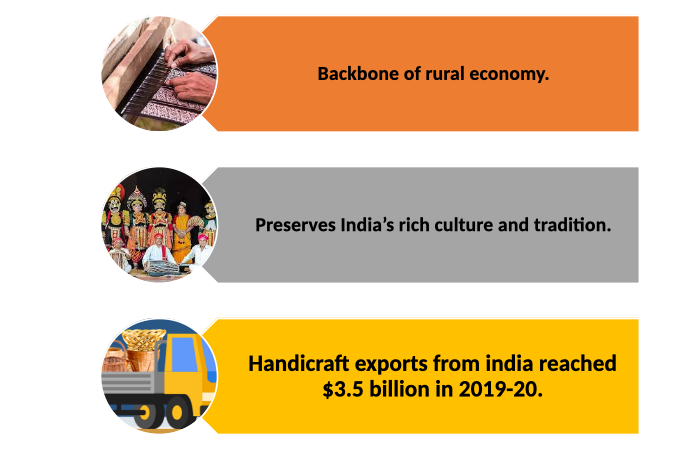
Challenges and appropriate way forward:
Conclusion
The artisan economy is all pervasive and crucial for inclusion in society. So government’s active measure is the need of the hour. Announcement to establish ‘Unity Malls’pan India, in the union budget 2023, strengthening platforms like ‘Crafts Villages’ is much needed.
Chapter 6:Fostering Rural crafts through one District one product
Introduction
One District One Product(ODOP) is a welcome initiative taken by the government of India to foster inclusive development by exploiting the export potential of the local economy.
One District One Product(ODOP)initiative:
1. The concept was taken from the Japanese business development concept ‘One Village One Product’ (OVOP).
2. The primary objective is to create a sustainable environment for art and craft products.
3. The sole aim was to recreate and revive the lost innovative products and processes to safeguard traditional knowledge.
4. Uttar Pradesh is the first state to implement the ODOP in India in 2018. Considering its success, the central government implemented it in all the states and UTs.
5. It includes agricultural and non-agricultural products, including food grains, foodstuffs, handicrafts, handlooms and other essentials.
6. It will also transform local traditional skills into profit-making ventures.
7. This initiative will help in reaching buyers outside India.
8. the ODOP scheme has recently been merged with the ‘Districts as export hub’ (DEH) initiative of the Directorate General of Foreign Trade (DGFT), Department of Commerce.
The primary goals of the One District One Product(ODOP)initiative:
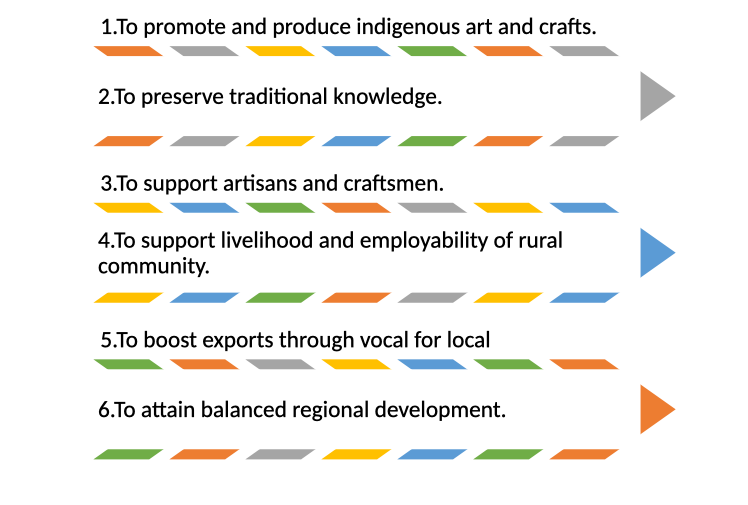
List of art & crafts and places of production
Source: Kurukshetra
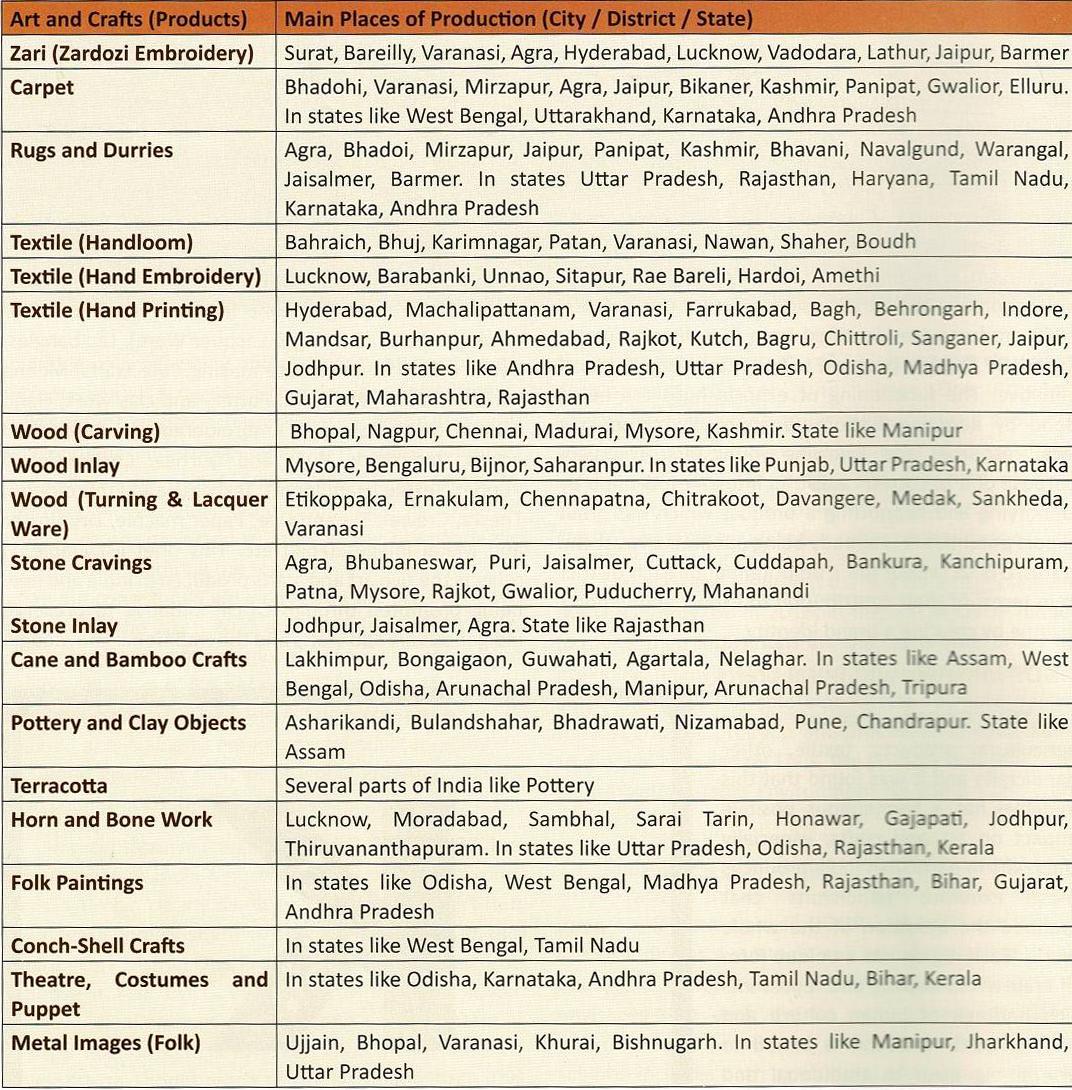
Source: Kurukshetra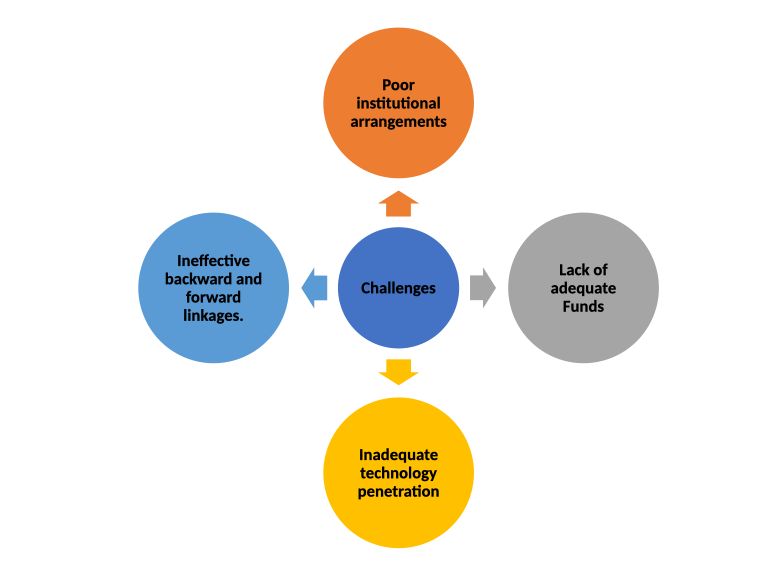
Conclusion
The ODOP scheme has significantly boosted the confidence of artisans, craftsmen, and rural entrepreneurs and their holistic approach to life, self-reliance and socio-economic empowerment, thereby making India a more robust economy in attaining Aatmanirbhar Bharat.
Chapter 7: Traditional Bell-Metal Industry of Assam
Introduction
Sarthebari has been the centre of Assam’s centuries-old traditional bell metal craft industry since King Kumar Bhaskarvarmana’s age.
Raw materials and product range
1.Bell metal is an alloy comprising copper(78%)and tin(22%).
2. The product is manufactured in a typical Kanhar-shaal unit comprises five to six artisans. The head artisan in whose house the kanhar-shaal is located is called ‘Oja Kanhar’, and his assistants are called ‘kanhar’.
3. The bell metal products have a wide variety, covering as many as 108 items. Some of them are:
- Kanhi–Taditional Assamese dishes and plates.
- Baati–Bowls of various shapes and sizes.
- Bota–Round trays with a stand.
- Taal–Cymbals of several varieties are used as religious musical instruments.

Potential market
- Assamese households are the prominent consumers of bell metal products.
- Besides the demand for religious and traditional handmade bell items in Arunachal Pradesh and Sikkim, there is also a big market for sarthebari in several nearby countries.
- Buddhist monasteries and temples in Bhutan, Myanmar, Thailand, Srilanka, and Nepal require several musical instruments (cymbals) and utensils.
|
Titbits for Prelims Pushpa kanhar, a master bell metal artisan, played a significant role in the ‘Raij-mel’ peasants’ uprising in 1894 against increased land tax by the British. He introduced ‘jail-kanhi’ and ‘jail-baati’. |
Conclusion
There is a scope for covering Assam’s bell metal industry under the ‘Act East policy‘, but achieving the target without institutional support is difficult. An overall policy providing health security, institutional financial support, training, and bridging marketing gaps can bring positive changes. The government of Assam’s measures like common facility centre, sales tax and loan weaver can be a suitable way forward.
Chapter 8:Promotion and Development of Handloom and Handicraft Sector
Introduction
The history of Indian craft and art is as ancient as the Indus Valley civilisation and has been evolving since the growth of civilisation. With the ages, India has assimilated diverse cultures and developed as a stronger and more resilient country.
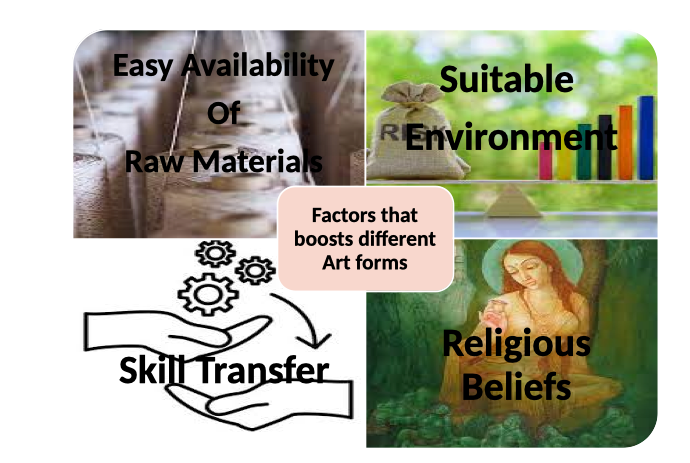
Local factors have also played a vital role in developing different art forms in India. Here are some examples of the same:
- The clay pottery in Aurangabad village near Gorakhpur, UP, has grown due to the availability of the particular clay.
- Kanjeevaram sari has motifs drawn from nearby temples. similarly,
Jamdani, Kota Doria, and Paithani have unique regional influences.
- Bangle making and lacquer jewellery was grown around lacquer-producing areas like Rajasthan.
- The furniture in South India has sandalwood with a lot of inlay work and figurines.
- Pashmina is a goat wool fabric product from Ladakh and Jammu & Kashmir.
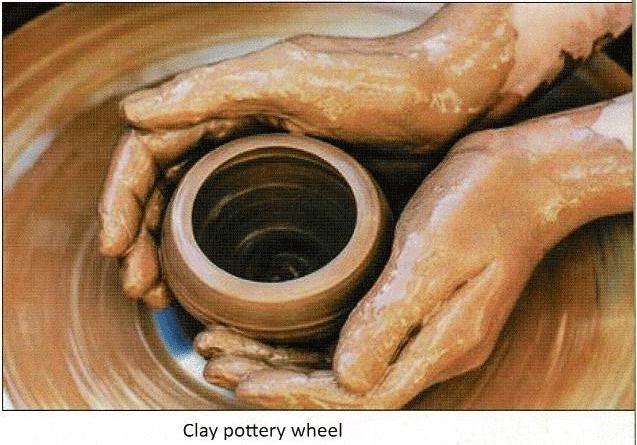
Source: Kurukshetra
Position of art and crafts during the British era
1. The production of art and crafts declined during British rule due to the absence of patrons of crafts and commercial pursuits of the government.
2. However, it survived due to local needs and support. for example;
- Brassware used in religious ceremonies was a local need.
- Filigree or bidri work was supported by the elite and the surviving royal families.
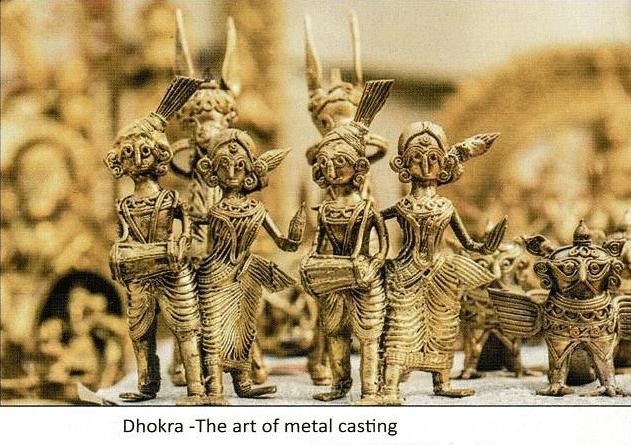
Source: Kurukshetra
- Some of the arts were preserved due to the passion of the families, like the Salvi family of Patan preserved patola saris.
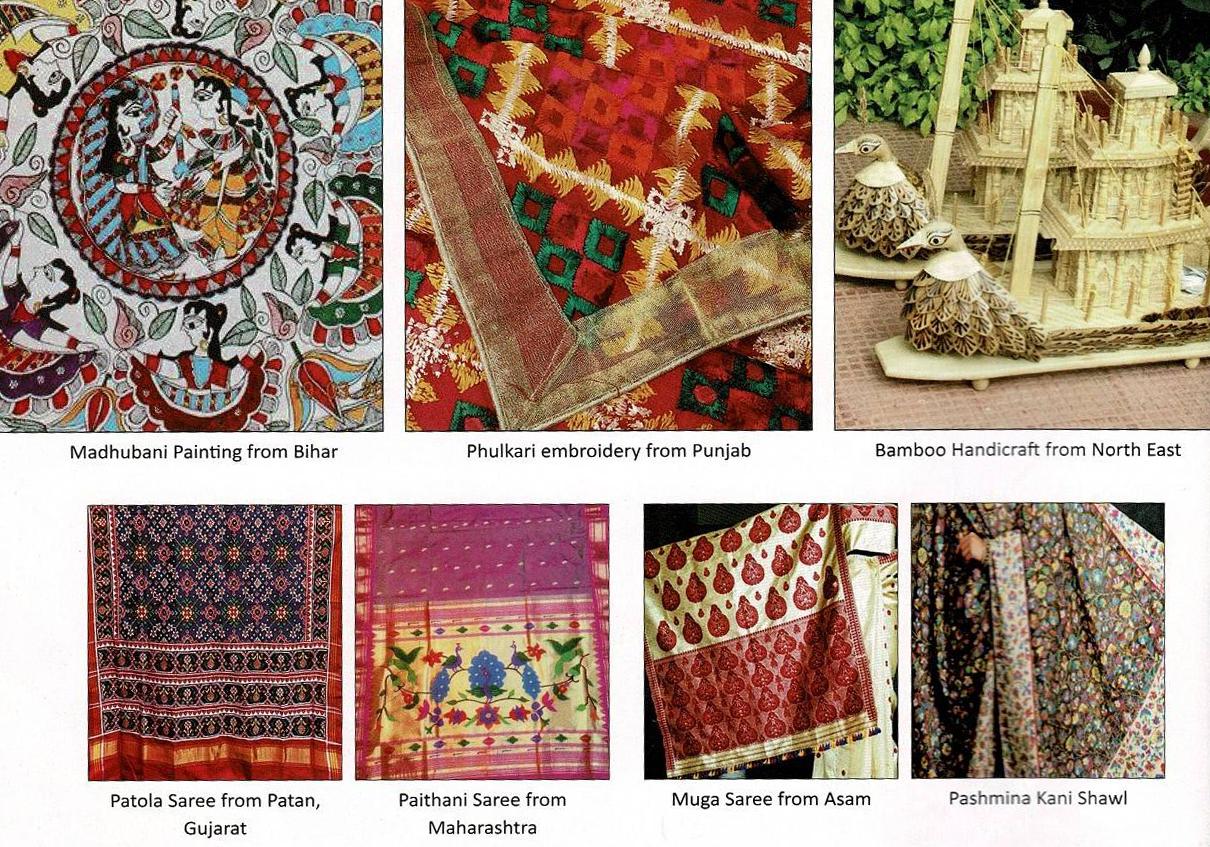
Source: Kurukshetra
Conclusion
The handloom and handicraft sector is an unorganised and decentralised industry in the rural industry in rural areas of the country. To boost the sector, many initiatives are taken to standardise the products like Handloom Mark, silk mark, and India Handloom Brand (IHB) to indicate quality certification. With this support, the handloom and handicraft sector are gradually becoming self-reliant.

